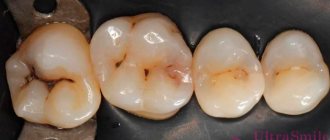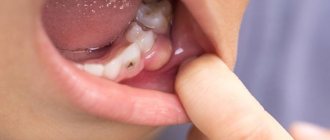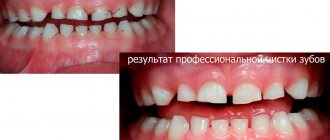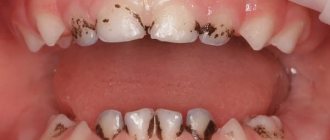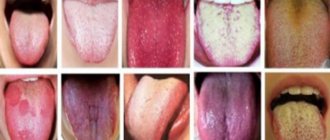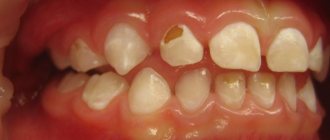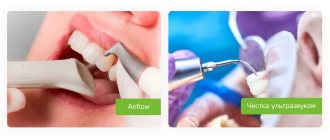In most cases, dental plaque is the cause of insufficient oral hygiene. But it also happens that people who are very sensitive to hygiene issues develop black plaque on their teeth.
The reasons for its appearance in adults and children differ : if in the former it is a consequence of drinking large amounts of tea and coffee, as well as smoking, then in the latter it may be associated with the activity of certain bacteria, the use of mouthwashes and the use of chewable vitamins.
Types of plaque
Plaque on teeth is divided into two large groups:
- the occurrence of which is associated with external contamination of the tooth;
- appearing due to the deposition of pigments.
If oral hygiene is not maintained, plaque may appear on the teeth:
- soft microbial;
- mineralized;
- hard, often called tartar.
If everything is in order with hygiene, then black plaque is a consequence of:
- regular consumption of tea, coffee and nicotine;
- use of medications with high iron content;
- vital activity of chromogenic bacteria;
- use of certain types of rinses and antiseptics.
Content:
- Why isn't every spot a black tooth decay?
- When there is black caries, but it is still not treated
- How to deal with little black caries
- When black caries still needs to be filled?
Sooner or later, small dots or dark-colored depressions appear on the teeth of any person. They are usually perceived as caries. But, when visiting a dentist, the patient may be told that he does not need to treat his teeth. Why is this happening? Is it true that not every black spot on the crown of a tooth is a cavity?
Bacterial plaque on teeth: causes
Soft or, as it is also called, bacterial plaque has a soft consistency, so it is easy to get rid of it with the help of an ordinary toothbrush. The main place of its accumulation is the neck of the teeth.
Harder plaque that cannot be removed with a brush is called tartar. It occurs during the mineralization of soft plaque with phosphorus and calcium salts present in saliva.
Why does plaque form?
There are constantly a huge number of bacteria in the mouth, which, firstly , multiply, and secondly , leave behind waste products. Even if you brush your teeth regularly, plaque cannot be avoided: within 6 hours after thorough brushing, you can easily notice, without resorting to the use of specialized equipment, a bacterial mass on the surface of the tooth enamel. A surge in microbial activity is observed immediately after eating: leftover food in the mouth forces bacteria to begin intensive processing.
At the same time, even small pieces of food that are invisible to the human eye are enough for microorganisms: they can feed on a film consisting of carbohydrates and proteins that invariably remains on the surface of the teeth after eating, and on food debris that gets into the spaces between the teeth. In this regard, it is imperative to brush your teeth for 15 minutes after each meal, since the mass of bacterial plaque can increase several times in volume in 1-2 hours. Plaque accumulates especially intensely on the necks of teeth in people who like to snack on a bun or something sweet between main meals.
Almost immediately after the soft plaque appears, the process of mineralization begins, as a result of which it gradually hardens. The period of primary mineralization (i.e., when the plaque, in simple terms, “sets” but still remains loose) is 10-15 hours. When the plaque finally hardens, its surface becomes ideal for the formation of deposits.
What is black caries?
There is no such term as black caries in dentistry. But among ordinary people this is the name given to the stage of the carious process at which the teeth darken. How does this happen?
“Black caries” may be at the initial stage. In this case, first white and then black dots form on the surface of the enamel - areas of demineralization. In these places, the enamel is thinned and vulnerable to the damaging effects of acid. If you do not pay attention to the blackheads in time and do not treat them, then the caries will go deeper and spread to the dentin.
Sometimes “black caries” is a carious lesion in which a hole has already formed in the tooth. Bacteria produce organic acids and gases, which not only destroy the structure of tissues, but also stain them. With caries, black spots can even show through tooth enamel.
Pigmented dark plaque on teeth
The main reason for the appearance of such plaque in adults is smoking, drinking coffee and tea. Maintaining hygiene guarantees the absence of bacterial plaque and tartar, but if you neglect it, black plaque will not take long to appear. Pigments adhere very well to enamel covered with bacterial plaque formed as a result of infrequent brushing of teeth.
Types of pigment plaque include:
- brown coating that occurs from regular consumption of tea and coffee in large quantities;
- accumulation of nicotine deposits;
- darkening of the enamel as a result of taking medications containing iron;
- proliferation of bacteria that form dyes (they are called chromogenic);
- change in enamel color after using antibiotics;
- blackening due to diseases of internal organs.
If plaque is caused by bacterial factors, then regular thorough brushing of teeth, the use of rinses and floss reduce the likelihood of its occurrence to a minimum. However, if the reason for the appearance of plaque lies in the influence of dyes, maintaining hygiene to prevent it will not help.
Black plaque on children's teeth , the causes of which are associated with the activity of chromogenic anaerobic bacteria, appears in the form of spots localized in the neck area. Actinomycete bacteria produce hydrogen sulfite, which reacts with iron (found in saliva and red blood cells). As a result, a form of black iron that cannot be cleaned off with a regular brush is deposited on the surface of the teeth. Chromogenic coloration can also be orange, green and brown.
Black plaque on a child’s teeth can also form for other reasons . It appears due to:
- the use of antiseptics that contain chlorhexidine, benzaclonium chloride, as well as essential oils (the latter are found in the popular Listerine product);
- consumption of foods rich in iron, as well as vitamins with a high content of iron.
Conclusion:
Typically, dental plaque has nothing to do with the pathology of the gastrointestinal tract.
I had separate observations that plaques (not like Priestley’s plaque in appearance) decreased in parallel with the treatment of reflux in children with specialized complaints, but global conclusions cannot be drawn from this.
If the dentist, when trying to clarify the cause of plaque that forms too quickly, reveals dyspeptic complaints and some suspicious symptoms (sour breath, thick coating on the tongue), a referral to a gastroenterologist seems quite logical.
5, total, today
How to remove plaque from teeth on your own
Many people do not like to visit the dentist again, especially when it comes to removing plaque, which does not cause much inconvenience. The reasons for this are clear: lack of free time and reluctance to pay for the procedure.
You can try to remove plaque from your teeth at home, but this will only work if there are no subgingival deposits and the plaque layer is thin.
The first method involves using a special toothpaste to remove plaque with abrasive substances. The label of such pastes must indicate the RDA indicator, indicating the degree of abrasiveness. In pastes that eliminate plaque, its value should exceed 100. But such pastes cannot be used on an ongoing basis. If the paste contains pyrophosphates, then it can help get rid of tartar, since they have the ability to dissolve its matrix.
The most effective of these pastes are:
- President White Plus. The abrasiveness index is 200 units; in addition, the composition contains silicon dioxide, which has abrasive and polishing properties. You should not use the paste more than once a week.
- Lacalut White. According to the abrasiveness index (RDA=120), it is more gentle than the previous sample. The composition contains pyrophosphates, which make the plaque loose.
The second method is to use a special toothbrush, which allows you to remove plaque yourself. Recommended use:
Signs of violations
Blackening of a tooth can be discovered by chance - for example, when replacing a bridge, one of the supporting teeth turned out to be dark. Or, the fact that there is a rotten or decaying tooth under the crown is indicated by indirect signs:
- An unpleasant odor that is noticed by the patient himself and those around him.
- The tooth reacts to temperature and strong tastes. If you run your tongue over the crown, you will notice a gap between it and the gum.
- Pain. Periodic or constant. Or itching or other strange sensations.
If one of the symptoms appears, you should immediately consult a doctor. Even when there is no sharp pain and unpleasant sensations appear and go away on their own. The tooth under the crown has already begun to deteriorate and the sooner treatment is started, the more effective it will be.
Plaque on a child’s teeth: treatment
Removing bacterial and chromogenic plaque in a child will be no different from a similar procedure recommended for an adult: ultrasonic cleaning and AirFlow are used in the same way.
However, chromogenic staining of teeth may return over time. The only possible solution to the problem is regular professional cleaning by a dentist. To make visits to the dentist as rare as possible, your child should be taught to use an electric toothbrush, the pulsating circular movements of the head of which perfectly break up plaque.
Accelerated formation of deposits is promoted by blood in the oral cavity, so the child’s gingivitis must be treated. The use of chlorhexidine and antiseptics based on it should be abandoned.
Smoking cigarettes and cigars
Black-brown plaque, tightly adjacent to the necks of the teeth on the inside of the row, appears as a result of smoking. In the process of smoking a cigarette or cigar, resins and carcinogens are deposited on the enamel, which contribute to pigmentation. This bad habit provokes the emergence of many dangerous problems and dental diseases. Which ones? You can read more about this in the feature article on our website.
Do not forget that by consuming cigarettes, you expose the enamel to strong temperature changes, due to which it cracks, and any pigment from food and drinks gets into the cracks much more easily.
Notice
: Undefined variable: post_id in
/home/c/ch75405/public_html/wp-content/themes/UltraSmile/single-item.php
on line
45 Notice
: Undefined variable: full in
/home/c/ch75405/public_html/wp-content /themes/UltraSmile/single-item.php
on line
46
Rate this article:
( 1 ratings, average: 5.00 out of 5)
plaque
- Evteev S.S., Lebedeva S.N., Kharitonova T.L. Etiological factors of dental discoloration // Bulletin of medical Internet conferences. – 2022.
Expert “In order to prevent plaque from spoiling your smile, you need to undergo preventive examinations at the dentist and professional hygiene twice a year. It must be remembered that plaque can form not only on natural teeth, but also on artificial materials used for restorations. Restored teeth also require careful hygienic care.” Dentist-therapist Elina Ruslanovna Dzagurova
Consulting specialist
Dzagurova Elina Ruslanovna
Doctor rating: 9.5 out of 10 (2) Specialization: Dentist-therapist Experience: 11 years
Comments
Recently, my wisdom tooth, which had been in for sooo long, finally came through completely. But it came out black and ached a little when pressed. What could it be?
Alice (04/12/2020 at 5:14 pm) Reply to comment
- Dear Alice, perhaps the wisdom tooth was affected by caries, pulpitis or periodontitis even before it completely broke through. You need to be examined by a dentist to find out the cause of the problem and begin treatment. If treatment is not practical, the tooth will have to be removed.
Editorial staff of the portal UltraSmile.ru (04/17/2020 at 09:17) Reply to comment
I heard that some materials that dentists use to treat teeth can cause blackening of the enamel. Is this really so, what to fear during treatment?
Lyubov Vladimirovna (04.05.2020 at 12:21) Reply to comment
- Dear Lyubov Vladimirovna, in the past, dentistry actually used materials that could cause darkening of teeth, for example, silver amalgam fillings, but today they are not used, so treat your teeth without fear.
Editorial staff of the portal UltraSmile.ru (05/11/2020 at 09:20) Reply to comment
I have a very dark coating on my nylon dentures, can I bleach it?
Alexander Mikhailovich (05.28.2020 at 22:17) Reply to comment
- Dear Alexander Mikhailovich, nylon absorbs various dyes well and requires daily and very careful care. Unfortunately, artificial denture materials cannot be bleached. You, of course, can try to clean them with special tablets or take them to the dentist for professional cleaning, but such a measure will not remove deeply ingrained pigment; it will only remove superficial stains and destroy bacteria.
Editorial staff of the portal UltraSmile.ru (06.06.2020 at 14:09) Reply to comment

